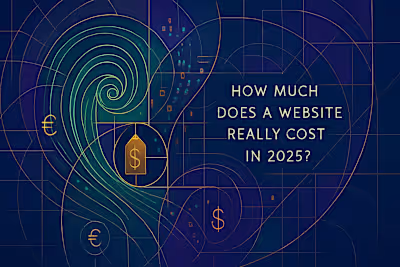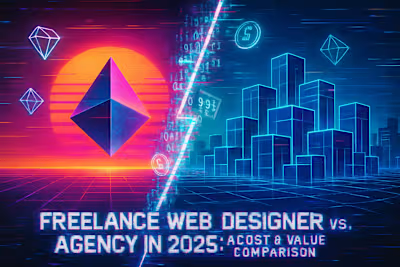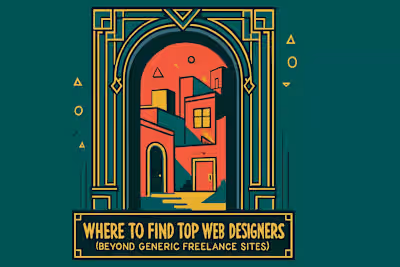7 Hidden Web Design Costs That Wreck Budgets (and How to Avoid Them)

7 Hidden Web Design Costs That Wreck Budgets (and How to Avoid Them)
Pre-Launch: Hidden Costs in the Design & Development Phase
1. Stock Photos, Fonts, and Premium Plugins
2. Scope Creep and Excessive Revisions
3. Content Creation and Migration
Post-Launch: The Ongoing Costs of Website Ownership
4. Web Hosting and Domain Renewal
5. SSL Certificate
6. Website Maintenance and Security
7. Email Hosting
How to Create a Bulletproof Budget
Ask the Right Questions Upfront
Get a Detailed Statement of Work
The Bottom Line
References
7 Hidden Web Design Costs That Wreck Budgets (and How to Avoid Them)
You've received a quote for your new website, and the number looks manageable. But here's the thing—that initial estimate is rarely what you'll actually pay. Many businesses get blindsided by unexpected expenses that can completely derail their project budget. Sure, understanding the different pricing models like hourly or fixed quotes is a great start, but knowing where these sneaky costs hide is what really matters for your financial planning.
This knowledge helps you see why investing in quality over the lowest cost from the outset is actually the smarter long-term strategy. It's also why you need to find professional web designers who are upfront about the total investment. Let's dive into the seven most common hidden costs that catch businesses off guard—and more importantly, how to avoid them.
Pre-Launch: Hidden Costs in the Design & Development Phase
Before your site even goes live, several costs can pop up that weren't in the initial proposal. These pre-launch surprises can quickly turn your carefully planned budget into a financial headache.
1. Stock Photos, Fonts, and Premium Plugins
Your designer shows you a beautiful mockup with stunning images and sleek typography. Looks great, right? But wait—those professional stock photos aren't free. Neither are those custom brand fonts that perfectly match your company's personality.
While many design elements come standard, premium stock photography can cost anywhere from $10 to $500 per image, depending on the license and quality. Need a specific font family for brand consistency? That's another $50 to $300. And those essential plugins that make your site function exactly how you want? Premium versions often run $50 to $200 each, with annual renewal fees.
Here's a real-world example: A small business owner recently told me they budgeted $3,000 for their website redesign. They ended up spending an extra $800 just on stock photos and premium plugins they hadn't anticipated. The slider plugin alone was $89, the booking system was $199, and they needed about 20 high-quality images at $25 each.
The worst part? Many of these costs are recurring. That plugin you bought? It needs annual renewal. Those stock photo licenses? They might expire if you want to use them in different contexts later.
2. Scope Creep and Excessive Revisions
"Can we just add one more thing?" These six words can blow your budget faster than anything else. Scope creep happens when project requirements expand beyond the original agreement. It starts innocently enough—maybe you want to add a blog section, or suddenly decide you need an events calendar.
Most web design contracts include a specific number of revisions. Go beyond that, and you're looking at additional charges. Fixed-price projects might seem safe, but even they have limits. Once you exceed the agreed-upon scope, you'll face change orders that can add 20-50% to your original budget.
I've seen projects double in cost because of scope creep. One client started with a simple five-page website. By launch, they'd added an online store, member portal, and custom integrations. Each "small addition" came with its own price tag.
The tricky part is that scope creep feels justified in the moment. You're excited about your new website and want it to be perfect. But those additions add up fast, especially if you're paying hourly rates.
3. Content Creation and Migration
Here's something that catches almost everyone off guard: your web designer builds websites, not necessarily the content that goes on them. That beautifully designed homepage needs compelling copy. Those service pages require detailed descriptions. Your about page needs to tell your story effectively.
Professional copywriting typically costs $50 to $500 per page, depending on complexity and the writer's experience. Need product descriptions for your online store? That's often charged per item. Want blog posts to launch with? Add another $100 to $500 per post.
Then there's content migration. If you're moving from an old website, someone needs to transfer all that content. It's not just copy-paste work—formatting needs adjustment, images need optimization, and links need updating. Migration can take 10-40 hours depending on your site's size, and at typical hourly rates, that's a significant expense.
One business owner shared how they assumed their 50-page website migration would be simple. It ended up taking 30 hours of work at $75/hour—that's $2,250 they hadn't budgeted for.
Post-Launch: The Ongoing Costs of Website Ownership
Congratulations, your website is live! But the spending doesn't stop there. These recurring fees are essential to keep your site online, secure, and functioning properly.
4. Web Hosting and Domain Renewal
Web hosting is like rent for your website—it's the space where your site lives on the internet. While not exactly hidden, many clients underestimate how hosting costs can escalate as their business grows.
Basic shared hosting starts around $5-15 per month. Sounds reasonable, right? But as your traffic increases, you'll need to upgrade. A growing business might need VPS hosting at $30-100 monthly, or dedicated hosting at $100-500 monthly. High-traffic sites or those needing maximum uptime might require cloud hosting, which can scale to thousands per month.
Domain renewal is more predictable—usually $10-20 annually for common extensions. But if you want to protect your brand with multiple extensions (.com, .net, .org), or if you're buying a premium domain, costs multiply quickly.
The real shock comes when your site becomes successful. That $10/month hosting plan won't handle thousands of daily visitors. One e-commerce client went from $15/month to $200/month hosting within six months of launching because their traffic exploded. They were thrilled about the growth but hadn't budgeted for the infrastructure costs.
5. SSL Certificate
See that little padlock icon in your browser's address bar? That's your SSL certificate at work, encrypting data between your website and visitors. It's not optional anymore—Google actually penalizes sites without SSL, and customers won't trust you without it.
While many hosting providers include basic SSL certificates free, they're often limited. Need an Extended Validation (EV) certificate that displays your company name in the browser? That's $150-300 annually. Running multiple subdomains? You might need a wildcard certificate at $250-500 per year.
E-commerce sites often require higher-level certificates for customer confidence. One online retailer discovered their free SSL wasn't enough when payment processors required a specific certificate level. The upgrade cost them $400 annually—not huge, but definitely not budgeted.
6. Website Maintenance and Security
This is the big one—the hidden cost that really catches businesses off guard. Your website isn't a "set it and forget it" asset. It needs regular updates, security monitoring, and backups.
Think of it like car maintenance. Skip the oil changes, and eventually, your engine fails. Skip website maintenance, and eventually, you'll face a hack, crash, or major malfunction. The average cost to recover from a hacked website? Between $1,000 and $10,000.
Professional maintenance plans typically run $50-300 monthly, depending on your site's complexity. This covers:
Software and plugin updates
Security monitoring and malware scanning
Regular backups
Performance optimization
Uptime monitoring
Basic content updates
One small business learned this lesson the hard way. They skipped maintenance to save $100 monthly. Six months later, their site was hacked, customer data was compromised, and recovery cost them $5,000 plus lost business during downtime.
7. Email Hosting
Your shiny new website is live, but wait—where's your professional email? That info@yourbusiness.com address isn't automatically included with web hosting anymore. Most businesses need separate email hosting.
Google Workspace starts at $6 per user monthly. Microsoft 365 begins at $5 per user monthly. For a small team of five, that's $300-360 annually. Need advanced features like larger storage, advanced security, or compliance tools? Premium plans can reach $20-30 per user monthly.
It seems minor until you calculate the total. A growing company with 20 employees on a business email plan spends $1,440-7,200 annually just on email. One startup founder told me they were shocked when their email hosting bill exceeded their web hosting costs within the first year of growth.
How to Create a Bulletproof Budget
Avoiding these hidden costs isn't about finding the cheapest option—it's about planning smart and communicating clearly with your web designer from day one.
Ask the Right Questions Upfront
Before signing any contract, arm yourself with these essential questions:
"What exactly is included in your quote?" Don't assume anything. Get specifics on number of pages, features, revisions, and what happens if you need changes.
"What are the estimated annual maintenance costs?" A responsible designer should outline ongoing expenses clearly. If they say "none," that's a red flag.
"Are there any third-party license fees I should know about?" This covers plugins, fonts, stock photos, and any external services your site might need.
"What happens if we need to make changes after launch?" Understand their hourly rate for future work and whether they offer maintenance packages.
"Do you provide content creation, or is that separate?" Know whether copywriting, photography, and content migration are included or additional.
"What hosting do you recommend, and what will it cost as we grow?" Get realistic projections based on your expected traffic and functionality needs.
"Are SSL certificates and email hosting included?" These basics are often assumed but rarely included in design quotes.
Get a Detailed Statement of Work
A handshake deal or vague proposal isn't enough. You need a comprehensive statement of work (SOW) that spells out every detail. This document should include:
Specific deliverables: Exactly how many pages, what features, which integrations. "Website design" is too vague—you need "5-page website including home, about, services, portfolio, and contact pages with contact form integration."
Revision rounds: How many rounds of changes are included? What constitutes a revision versus a new request? One client learned that moving a button was a revision, but adding a button was a change order.
Timeline and milestones: When will each phase be completed? What happens if delays occur? Are there penalties for missed deadlines on either side?
Payment terms: Beyond the total cost, when is payment due? Are there late fees? What about refund policies if the project goes sideways?
Ownership and licenses: Who owns the final design? What about custom code? Can you modify the site yourself later, or are you locked into using this designer?
Additional costs: Any known third-party fees should be listed. If exact costs aren't known, include estimates and who's responsible for overages.
Change order process: How are additional requests handled? What's the hourly rate? Is there a minimum charge for small changes?
The best SOWs I've seen include a section called "What's NOT included" that explicitly lists common requests that would incur additional charges. This prevents the "I thought that was included" conversation later.
Remember, a detailed SOW protects both you and the designer. It sets clear expectations and prevents those awkward conversations about money mid-project. One designer told me their business relationships improved dramatically once they started using comprehensive SOWs—fewer surprises meant happier clients.
The Bottom Line
Hidden web design costs don't have to wreck your budget. The key is knowing they exist and planning accordingly. That initial quote? Consider it your starting point, not your final number. Budget at least 30-50% above the initial estimate for a realistic total.
More importantly, choose designers who are transparent about total costs. The cheapest quote often becomes the most expensive project once all these hidden fees surface. A slightly higher upfront investment with a designer who clearly outlines all costs saves money and headaches in the long run.
Your website is an investment in your business's future. Treat it that way. Plan for the total cost of ownership, not just the initial build. Ask tough questions upfront. Get everything in writing. And remember—a successful website isn't just about looking good on launch day. It's about having the budget to keep it secure, updated, and growing with your business for years to come.
By understanding these seven hidden costs and following our budgeting strategies, you'll avoid the sticker shock that derails so many web projects. Your future self (and your accountant) will thank you.
References
Like this project
Posted Jun 30, 2025
Your web design quote is just the beginning. Discover the 7 most common hidden costs, from hosting to maintenance, and learn how to plan for them to keep your project on budget.











